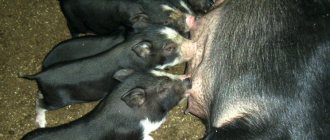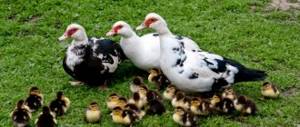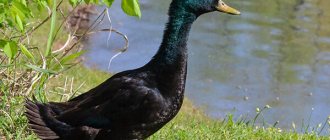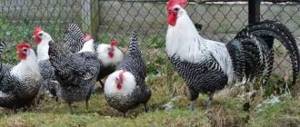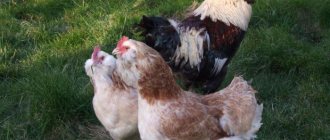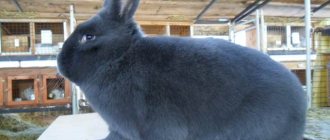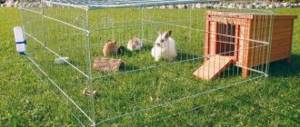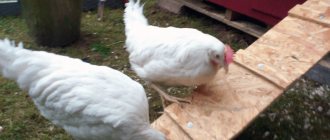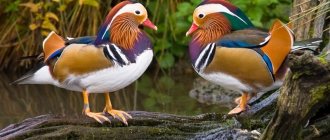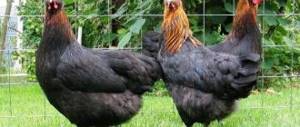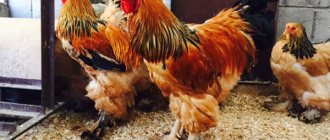Description of the Blagovarian duck breed
The Blagovarsk cross duck is one of the most profitable purchases, because breeding it is much easier and more profitable than any other breed of duck: less feed will be consumed, but the birds will very quickly increase in size. Raising Blagovarian ducks in an incubator is surprising with a high hatching percentage. Ducklings are tall and unpretentious, especially if there is a body of water near the site.
Poultry farming is one of the most popular types of agriculture, occupying a niche in meat production in the world. Poultry farming provides a number of products, the main ones being meat and eggs.
The description and characteristics indicate that the described breed was bred about 20 years ago in the Republic of Bashkiria, therefore cross ducks are also called Bashkir. The ducklings first appeared at the poultry farm in the city of Blagovar, which gave the name to the breed.
Description of the breed
The ancestor of the Blagovara cross was the Peking duck. Blavar ducks have a high early maturity and are characterized by low feed consumption (1 kg of weight per 3.5 units of feed). If the Blagovarian duck is kept for intensive breeding, calcium must be added to the feed, since without it the individuals may stop laying eggs. The rapid development of this breed allows it to reach a weight of 4-5 kg by the age of 2 months.
Egg production is also at a high level; birds can produce more than 200 eggs per year. The color of the duck is mostly white, which makes it easier to sell feathers and down. Blagovarian individuals live up to 20 years, but stop laying eggs by 5-6 years. The line of the Bashkir breed is very popular among farmers, so before getting such a breed, it is easy to find out what characteristics the ducks have, a full description and photo of the breed.
Nuances of breeding
The Blagovarsky cross belongs to the meat category, so in most cases these ducks are raised for slaughter. To organize your own farm, you should understand the features of their breeding.
In order for the business to be crowned with success, it is recommended to purchase young animals or hatching eggs of Blagovarian ducks from trusted breeders. Unscrupulous sellers may slip another hybrid, with worse productivity and low weight gain.
It is advisable to buy two-week-old chicks. By this time, external defects and character appear. The young animals must correspond to the above description of Blagovarian ducks and lead an active lifestyle.
Most of the brood is slaughtered when it reaches 60-100 days. By this time they are gaining marketable weight. Laying females and breeding drakes are left for breeding. Norm: one male for 3-4 females.
Duck breeding
To successfully propagate fruits, you need to choose the right producers. The ratio of ducks to drakes should be 5:1. When feeding breeding ducks, it is necessary to add calcium to the feed; if this is not done, they will not lay eggs much. It is advisable to keep a laying duck for up to 3-4 years.
An incubator is used to propagate the Bashkir cross breed. This individual was artificially bred, so the natural appearance of ducklings is almost impossible: ducks simply do not sit on nests or abandon eggs after a short period of time. The birth of ducklings from a mother hen is very rare; they are not Indian ducks, they do not have a developed maternal instinct. If you don't have an incubator, you can place eggs with other ducks or chickens.
Before you begin directly breeding the chicks, it is necessary to select the eggs: they must be of the correct shape, without damage. They are first harvested for up to 7 days, kept at room temperature, and then placed in an incubator. Eggs with a shelf life of more than 10 days are no longer useful in the production of young animals. The hatching period for ducks in the incubator is 26-28 days, while the temperature must be set at 37.5 to 38.5 ° C, humidity - about 50%, but at the time of hatching it must be increased to 80%. Blagovarian ducks are good because only 15-20% of unhatched eggs remain. Well-bred young ducklings weigh about 50 g, the color of the plumage is yellow.
After successful hatching, the ducklings must be properly fed. For the first 3 days, the ducklings are kept in a warm room under a lamp, then they are gradually introduced to grazing. At ten days of age, ducklings are allowed to approach water. Feeding ducklings in the first 1-2 days must be done independently. First, they are given a weak solution of potassium permanganate to drink, and then a crushed egg and hard-boiled porridge are poured onto gray cardboard. They are sprinkled with this food so that newborns can peck food from each other’s backs, because their instincts tell them to take moving food. After 3 days, the Blagovarian ducklings will begin to eat on their own. From 15 days of age, young animals are transferred to full nutrition. By 2 months of age, ducklings will weigh up to 4-5 kg.
Description and productivity characteristics of Favorit cross ducks, their breeding
Amateur poultry farmers keep on their farms not only common breeds of ducks, but also productive crosses that have interesting qualities.
Duck Favorite is one of these interbreed crosses, which is suitable not only for industrial, but also for home breeding.
Let's take a closer look at its description and productivity characteristics, as well as the features of cultivation in private poultry houses.
Origin
This cross was obtained in Bashkiria at the Duet LLC duck farm in 1998. The main breed with which the work was carried out was Peking.
Individuals that were selected for certain qualities were crossed with representatives of the Bashkir and black white-breasted breeds.
The goal of the breeding work was to create early-maturing ducks with large body weight, decent egg production and a calm character. Favorite ducks meet all these characteristics.
The new meat and egg cross was named Favorite. Most of the ducks currently bred (since 2005) are located in the Blagovarsky breeding farm, which is their main producer. A certain number of livestock are kept by amateur poultry farmers.
Description of ducks
The exterior of Favorites is typical for ducks of meat breeds:
- large, long and wide body;
- the body is located almost horizontally;
- moderately pronounced breasts;
- medium length neck;
- large head with a long and flat beak of a dark gray-blue or dirty yellow color;
- powerful short legs of the same color;
- thick fluff used in industry.
According to the Blagovarsky PPZ description, blue Favorite ducks have ash-gray plumage all over the body and a white breast.
But this color is unstable, if you breed representatives of the cross by crossing them with each other, in the 2nd generation individuals will appear not only blue, but also lighter or darker than the typical color, as well as black (at least a quarter of the total number), white, brown, fawn and even intermediate options between these colors. At the same time, productivity often decreases.
Productivity characteristics
Since this cross is large, birds at 2 months of age can already weigh 3.7 kg for drakes and 3.5 kg for ducks. At this age they are ready for slaughter.
If they grow up to 3-4 months, then males can already weigh 4.5-5 kg, and females, respectively, 4 kg. With intensive feeding at 6 months, adult drakes can gain 6-7 kg.
The meat has high taste characteristics, fat content is up to 37%.
The favorites can also boast of good egg production rates - from one laying duck in 40 weeks of productivity you can get 230 eggs with an average weight of 90 g. Females begin laying eggs at 6 months.
Advantages and disadvantages
Favorites would not be bred in industrial poultry houses if they did not have certain advantages, namely:
- precocity;
- large body, and therefore a large carcass;
- good quality meat;
- calm character (almost no noise);
- good egg production.
Disadvantages: lack of brooding instinct and the fact that representatives of the cross or eggs for incubation are quite difficult to obtain.
Breeding at home
Since this is a cross and not a breed, it is advisable to purchase ducks for breeding at home from specialized poultry farms.
If you want to reproduce them yourself, then you need to take into account the fact that when crossing 2 blue ducks, the brightening gene that is in their genotype negatively affects not only the fertilization of the eggs, but also the course of the embryonic development of the duckling inside them. It is noted that it leads to the death of up to 1/4 of all embryos.
Favorite ducks lack the brooding instinct, so an incubator will be needed to hatch ducklings. An egg collected from ducks older than 7 months is placed in it. The best ones are selected, no smaller than the standard size, without damage, fresh (no more than a week from the date of demolition). The incubation technology is the same as that of other duck breeds. Favorit cross ducklings are hatched on the 28th day.
To distinguish a duck from a drake, you will need to wait until the Favorites molt, after which the male will have feathers curved up near his tail, the female will not have them.
Features of care
Favorite ducks need to be kept in a good, solid barn. It should be spacious, for each grown individual there should be at least 0.5 square meters. m area. Although, allegedly, these ducks are not afraid of dampness and they can even put water for bathing directly in the nesting box, it is better not to do this, but to organize a paddock next to it, into which to drive the ducks.
In the summer you can keep them out for a walk constantly, driving them into the barn only in bad weather. It is advisable to insulate the duckling house for the winter, despite the fact that these ducks tolerate the cold well. Favorites are calm, so they can be kept with other duck breeds and chickens.
How to feed the Blagovarian duck
Blagovarian ducks must eat well, so this issue must be approached responsibly. The Blagovarian duck breed should receive all the necessary vitamins and minerals along with its diet. Blagovarian ducks are omnivores; they do not require an abundance of food.
To save on feeding, some farmers use agricultural waste:
- Beet pulp is a very nutritious food, 5-8% of grain mixtures.
- Bran should make up 10-20% of the weight of grain feed.
- Cake and meal are used at about 5-10% of the weight of grain feed.
- Meat and bone meal has a huge protein content, reaching a ratio of 1/2 to all other components; no more than 5% should be used.
- Milk and milk mixture are used to make mash.
- Ducklings really like cottage cheese; they should be fed with cottage cheese until they are 15 days old.
- It is advisable to use 20% or more of root vegetables and succulent feed, as they have a good effect on the taste of the resulting meat.
If it is possible to feed algae, you can save up to half of the grain feed. Small shellfish are an excellent source of calcium, but should be used up to 2% in the mash. Compound feed from cereal crops is the most necessary thing for poultry: it is easily digested and quickly absorbed in the body. Birds should eat at least 3 times a day.
Duck rearing technology
Poultry farmers claim that the Blagovarskaya duck does not require complex care. Financial costs are associated only with the purchase of feed. It must be balanced and contain vitamins and minerals. The diet includes fresh vegetables and premixes.
Cleanliness is considered a distinctive feature of the breed. Ducks love to bathe, preen their feathers, and keep themselves clean. The poultry farmer needs to provide the birds with clean water baths and remove droppings from the floor of the barn more often. However, these procedures do not take much time.
Poultry house arrangement
The productivity of a herd largely depends on the conditions in which it is kept. Before having ducklings, it is important to properly arrange the house:
- The estimated number of livestock is calculated taking into account the area of the existing barn. Month-old individuals can be accommodated up to 3 heads per 1 m2.
- The floor of the poultry house is disinfected by filling it with slaked lime. Lay bedding for warmth. Any organic matter will do: sawdust, straw, seed husks. The litter is changed promptly as it becomes moist. The floor is cleared of any remaining droppings.
Advice! It is advisable to add peat to the litter. The natural component is considered an excellent antiseptic and absorbs moisture abundantly.
- In the fall, all the cracks in the barn are covered. Rodents enter through them and introduce infection. Additionally, cracks lead to the formation of drafts, which cause colds in ducks .
- Daylight hours for ducks are extended to 12-14 hours. If the shed is insulated, you can use red lamps. Along with lighting, the inside of the poultry house will be heated. If there are not enough lamps, heating is made from an oil-fired electric heater.
- Ventilation is definitely needed. The current system removes dampness and ammonia vapors from the poultry house. By adjusting the ventilation, the humidity is maintained at 75% and the air temperature at 15 to 18°C.
- From the equipment inside the poultry house, feeders and containers with sand are placed. It is better to use closed drinking bowls so that there is less dampness in the saran. It is advisable to take baths for bathing into the enclosure.
See also: What is the difference between mulards and indo-ducks: characteristics of the breeds and which is better
The run is attached to the poultry house from the manhole side. It is enough to fence off the area with a net. It is advisable to cover the aviary with a canopy so that the ducklings can walk in winter and autumn in bad weather.
Feeding
A complete diet for ducks consists of feed, grass, vegetables, fruits, and root vegetables. You can't skimp on portions. Malnutrition will lead to weight loss and vitamin deficiency. To digest food, birds are given separate baths with sand and fine gravel.
After birth, small ducklings are fed crushed boiled eggs. The first day they give only the yolk. Crumbs are sprinkled on the back to develop the grasping reflex. The white is mixed into the yolk from the second day. The chicks are fed eggs for 3 days.
From the 4th day of life, the diet is varied. Finely chopped greens, low-fat cottage cheese, and meat waste are added to the egg. Additives include chalk and meat and bone meal. From 10 days, young animals are transferred to starter feed or homemade grain mixtures. The birds are fed boiled potatoes, and yeast and dairy products are added to the mash. A similar diet is maintained until one month of age.
In summer, adult ducklings can be fed 1-2 times when free-ranging on the river. Before slaughter and with the onset of cold weather when kept in a barn, the number of feedings is increased up to 4 times. In the morning and at lunch they give wet mash with grated vegetables and boiled potatoes. After lunch, dry food is fed twice. Crushed raw grain is processed longer in the stomachs, the bird remains full until the morning. In winter, green fodder is replaced with silage and hay. Grain mixtures are enriched with mineral and vitamin supplements.
The Blagovarskaya duck gains weight best when fed with fattening compound feed. In the factory, the food is enriched with the correct proportions of the constituent components. Before slaughter, fishmeal and other additives that can affect the taste of meat are excluded from the diet.
Contents of Bashkir duck
The cultivation and breeding of such a breed should be carried out according to all standards, since the requirements for it are very serious; this is the only way to obtain healthy and strong individuals. To keep ducks, you need a room, even if their breeding occurs in the summer. You can build a house for ducklings from anything, as long as you have enough imagination and money. The room should be equipped with nests and special thresholds for easy access to them.
The nests should be in the form of wooden boxes 50*50, their height should also be 50 cm.
Several birds will climb into one box. They need drinking bowls, which can be used as a trough; the feeders should be wooden and have a partition-handle on top so that the birds do not climb into them. The floor in the poultry house must be covered with bedding, which can be used as sawdust, peat, straw and wood shavings. Duck breeding is a convenient type of agriculture that does not require much labor. Feed costs are minimal, and after 2 months, with proper care and breeding of cross ducks, the poultry farmer will have an environmentally friendly product.
Origin
The bird's homeland is the Republic of Bashkorstan. The pedigree breed was bred at the Blagovarsky State Plant, whose breeders tried to develop a more productive cross. Since the death of poultry always brings losses, the work was aimed at creating strong individuals. The Blagovarsk duck has its roots in the Medio breed. The line is considered one of the most complex hybrids in the world.
The breeding of a new cross is always under the strict control of livestock specialists and within the framework of certain rules. Crossbringing is a rather difficult process and requires hard work. There is no doubt that the breeders preserved the qualities of waterfowl on the maternal and paternal lines, which are designated B-1 and B-2. Moreover, when a new breed is obtained, the best individuals are selected.
Features of the cross
In terms of its characteristics, the Blagovarskaya duck is superior to hybrids, which have established themselves as profitable poultry.
The “progenitor” lines are distinguished by high egg fertilization, if we take the ratio to the herd, then the maternal line is 94%, the paternal line is 93%; productivity of a brood of ducklings – 70-80%; egg delivery - about 20 pcs. per month. The paternal cross line is considered a meat breed. These are large hybrids with a long body and neck. Birds from this “pedigree” behave calmly and balanced.
Unlike other breeds of ducks, Blagovarian hybrids do not lose their weight during molting, and this process occurs much quickly for them.
Birds are not demanding of large amounts of feed, but this does not affect their weight, and their meat has excellent taste.
Duck breeding is very successful in an incubator, since a larger number of eggs (90%) pleases the owner with the appearance of a new individual in the poultry yard. Ducklings are famous for their rapid growth and weight gain. The fledging of young animals occurs very quickly.
Already at 2 months of age, the chicks gain about 3 kg. This is the right time for slaughter. Because of this feature, you can get 2-3 batches of duck generation over the summer and multiply the amount of meat obtained. The weight of a duck egg is about 90 g.
The breed has stable immunity, which is important for raising poultry.
Suitable conditions
Raising Blagovarsky ducks begins with preparing the ducklings and the surrounding area.
- The new cross of hybrids feels great in garden plots. The bird loves to roam around, so you need to provide enough space for it and create a fence.
- A pond is also required on the territory of the poultry house. If Blagovarsky ducks grow in natural conditions for their species, then they will please the poultry farmer with greater returns.
- In the room where the birds will live, it is important to create conditions for laying eggs. It is better that the nests are placed on shelves with steps or thresholds attached to them. Wooden boxes can be used as a place for eggs. They should be spacious and not too high so that the duck can sit comfortably and easily. Several birds can fly in large, oblong nests at once.
- You need to install drinking bowls in the duck house. They should be long so as not to create competition between birds. Old troughs are well suited for this purpose.
- Feeders can be built round or rectangular, depending on what material the owner has. The main thing is to create an obstacle for the birds so that they do not trample on the food. To do this, handles are attached to the feeder at a low level from it.
- Suitable bedding can be straw, fresh wood shavings or rotted sawdust.
Conditions of detention
In order for the raising of Blagovarian ducks to give a positive result, it is necessary to follow the regime and diet, and provide normal breeding and rearing conditions for the ducks.
This duck has good adaptive abilities, because... it was bred artificially.
The Blagovarskaya white bird is unpretentious, so it does not need a separate room. It will be enough to equip a poultry house in which the birds can eat and rest.
The characteristics of the breed indicate that the cross requires a small exercise yard. It would be good if there was a reservoir in which the livestock could get duckweed and small pebbles to cleanse their stomach.
- Duckweed saturates the body with the minerals it needs;
- Birds will be able to clean their feathers and nasal openings;
- Boat walks have a beneficial effect on the skeleton and muscles.
If there is no natural reservoir on the farm territory, then the farmer must create an artificial one.
For duck breeding to be productive, the poultry house must meet the following requirements:
- absence of drafts;
- ventilation system;
- full lighting;
- temperature maintenance system in cold times;
- nests, drinking bowls, feeders.
The poultry house is built on the site of old buildings or a new building is created. The floor must be insulated with straw, shavings or sawdust. The flooring is changed regularly, because... it is capable of spreading infectious diseases. To control the humidity and cleanliness of the air in the barn, it is worth equipping a ventilation system. If the duck house is designed for a small population, then a tubular system is made. If this is a large industrial facility, a mechanical ventilation system is created.
Wooden nests measuring 40 by 50 cm are placed in the barn. They should be slightly isolated, so the ideal place for the nest would be a dark corner. An ordinary wooden or iron trough is suitable as a feeding container.
Blagovarian ducks quickly gain weight. Therefore, they should properly plan a nutritious diet, which depends on age:
- The first 3 days - feeding consists of boiled eggs and small cereals.
- Days 4-9 - ducklings are given meat waste and chopped greens, low-fat cottage cheese.
- 10-30 days - for ducklings of the Blagovarian breed, boiled potatoes, salt, and crushed grain waste are added to the menu. Some farmers provide yeast and fermented milk products.
To prevent ducks from gaining excess weight and, at the same time, weight loss does not occur during the period of intensive laying, a special diet is being developed
After a month, Blagovarian ducks eat mainly combined food. Greens and food waste must be added to it. To further strengthen the bones, there should be a feeder with chalk in the barn. The feeding process is simple, following the rules is a guarantee of successful weight gain.
Feeding requirements
When raising purebred birds, it is important to follow certain feeding standards. A balanced diet will affect both growth rate and weight gain. If the food is enriched with essential vitamins and minerals, the ducklings will be less susceptible to disease. It is important not to miss the moment of development of the chicks, since a weak duckling will never grow into a full-fledged duck.
The composition of the food also determines how the female will lay eggs. Calcium must be included in the feeding of Blagovarsky ducks. This substance takes an active part in the formation of eggshells. If there is a shortage of it, ducks will rarely lay eggs, or even stop doing so altogether.
The basic diet should include chalk, salt, gravel or sand. A favorite food for ducks is duckweed, which can be chopped up and mixed with feed.
External indicators
The white color of Blagovarian ducks is their distinctive feature. A beautiful bird becomes the “highlight” of the livestock, bringing benefits and aesthetic pleasure to breeders. Individuals are strongly built, the carcass is elongated, with a pronounced sirloin part.
Blagovarian ducks have a highly developed chest. The flexible neck of medium length is crowned with a large head with a bright orange beak. The paws are set wide apart, the membranes on them are orange or pinkish.
Blagovarsky drakes differ from ducks by the presence of a tuft of feathers on the neck, large dimensions and a rounded tail tip. Females have dull white plumage, and the part of the beak near the forehead is trapezoidal in shape.
By external data, you can determine the fertility of Blagovarian ducks. The lighter the tone of the beak and paws, the higher the productivity indicators.
Be careful: if the membranes and beak of the beetles become dull, this is an alarming signal. Perhaps the duck is sick. Or you are not taking good care of the bird. For example, they violated the rules for preparing a diet.
The nuances of feeding Blagovarian ducks can be found below. If this does not help, show suspicious animals to the veterinarian. In general, regular scheduled examinations by a specialist are a necessary measure to prevent diseases and the development of epidemics.
Reproduction and care
Poultry farmers who have a home incubator and are involved in breeding ducks know that the temperature regime in the first weeks of life of the chicks plays a huge role. The slightest violation can lead to the death of babies. When a new batch of young animals appears, a temperature of at least + 30 o C is created and over the course of 3 weeks it is gradually lowered to + 16 o C.
The behavior of ducklings helps regulate temperature correctly. If they are cold, they cuddle together and squeak loudly. When the room is hot, this affects the breathing of the young animals and such manifestations are immediately noticeable.
The room must be dry. Optimal humidity is 65-70%. Dampness and drafts lead to colds and death of ducklings. It was noted that during transportation of young animals there was a large loss of life due to hypothermia. This fact shows how much more practical it is to have your own incubator.
A separate batch of ducklings should not exceed a certain number, otherwise they will be crowded and the stronger ones will begin to push back the weaker ones. In the first week of life, no more than 35 individuals are placed per 1 m2 of area. By 2 weeks of age the number is reduced to 15, and as they grow older - to 10.
If weak ducklings are noticed, they need to be placed separately and fed from a pipette with a mixture of yolk and milk.
Month-old ducklings can be gradually accustomed to the street. They should not be released early in the morning while there is dew on the grass, or during rains. Moderate hardening will benefit the chicks.
Young animals should not be walked in direct sunlight. To protect them from excessive overheating, it is necessary to create a shelter around which to build a fence.
Feed purchased from a specialty store will be the safest food for small ducks. A substitute for special feeds can be barley or oatmeal mash with milk. Boiled eggs and low-fat cottage cheese are added to the porridge. After a week of age, finely chopped herbs can be added to the feed.
Poultry farming is a profitable business
Poultry breeding has always been considered a profitable business. Firstly, you can get environmentally friendly products for your family. Secondly, homemade meat and eggs are always easy to sell at the local market or neighbors. To help amateur poultry farmers, new breeds are provided, which are advantageous in that they require a small amount of feed. In this regard, the Blagovarian duck is a profitable purchase. For 1 kg of live weight there are 3.5 kg of bird feed.
Some tips
If conditions permit, the birds are released outside under the supervision of the owner. For example, in rural areas it would be good to walk ducklings on grass pastures. In their natural environment, they can find additional nutrition for themselves and replenish their diet with essential substances that may be lacking in special food.
Experienced farmers know how important it is to carefully monitor the growth and condition of young animals. It is necessary to monitor weak ducklings in a timely manner and take the necessary treatment measures.
The chicks may develop wounds due to them fighting among themselves. This can happen in a small room. Expanding the area and taking walks smooths out the problem.
To prevent bird diseases, it is important to create good ventilation in the outbuilding.
If a duck's bright legs turn pale, this is a signal that it will have to be treated.
In the description of the Blagovarsky duck breed it was mentioned that the bird is not stormy. This is a good feature for owners of multiple species of birds, as this feature will help avoid conflicts in the poultry yard.
It is better to buy ducklings from poultry farms.
How to care for and what to feed?
We recommend reading our other articles
- Gooseberry jam
- Mulard duck breed
- Peach variety Golden Jubilee
- How to choose the right melon
To keep ducks of the Agidel breed, you need a poultry house, walking and proper feeding. The poultry house will be discussed below; before walking, as a rule, it is a large, spacious place fenced with chain-link mesh or any other material. The fence should not be very high, but sufficient so that a frightened bird (after all, anything can happen) does not fly over it.
Inside, some useful green crops are planted on the ground for the bird to nibble on. A canopy is being installed on half of the walking area. It should be anything but a tree, since ducks need not only shade, but also protection from rain and hail.
Keeping Agidel ducks
The Agidel breed can easily do without a pond, but it is still recommended to have one. Water procedures have a positive effect on the quality of meat, egg production, and poultry health. The reservoir can be natural or artificial. Any large container buried in the ground and filled with water will be the greatest joy for birds; you can also throw fresh duckweed into the container. The water in the “reservoir” is changed daily or even several times a day, since when it is in the sun it will quickly heat up, and the birds need cool water.
It is best to let ducks in for “water procedures” in the morning. A trough is installed outside the enclosure, they are released there, they swim, and then enter the enclosure and walk for the rest of the day. This arrangement allows the feathers to dry completely before the ducks enter the house. If the bathhouse is placed in an aviary, then within a couple of days the nest will become very damp, which will lead to the formation of fungus.
Feeding ducks is not expensive. During the warm season, the bird is released outside, where it eats pasture throughout the day. In the morning and evening, the birds are fed in the poultry house. In addition to greens, the diet should contain grains and vegetables. The first are mixed and given in the morning, the second in the form of mash - in the evening. In winter they feed 2-3 times a day. If the duck Agidel begins to lay eggs or hatches offspring - 4 times. At the same time, additional vitamin and mineral supplements are introduced into the feed.
It is important to note that any inexpensive compound feed or mixtures of grains that are sold in stores are suitable for feeding. Vegetables for mash can be grated or cut into thin strips, as thick cubes will be difficult for birds to grab or eat.
Blagovarskaya duck - description of the breed
The Blagovarskaya duck breed was bred in Bashkortostan at the Blagovarsky PPZ relatively recently, but has already gained wide popularity and positive reviews. It is also well known under the popular name Bashkir.
Blagovarskaya duck is a representative of the musk breed of broiler-type ducks. It was reproduced on the basis of the hybrid Medeo of Kazakhstani origin and the domestic species Temp. In terms of its characteristics, the Blagovarka duck is largely comparable to the famous English Cherry Valley breed. The gene pool is formed by two lines: paternal B-1 and maternal B-2.
On the paternal side, the breed inherited fast growth, large size, short plumage, good meat quality, and weight retention during the molting period.
On the maternal side, the Blagovarka duck is characterized by high taste quality of meat, productive egg production, and high fertility.
History of the breed
Blagovarskaya duck is a cross obtained by Bashkir breeders in 1998. Thanks to their hard work, the cross is distinguished by high productive qualities. Ducks do not consume a lot of food, but they grow quickly; in addition, they are resilient and quickly adapt to new living conditions.
The body of the duck is strong, looks like a typical broiler
To create a new cross, well-known breeds of ducks were taken. White Peking duck is the main species used in breeding. It was from her that the Cherry Valley cross was obtained, and from it in turn came the X-11 cross. The genetic material of X-11 was taken to create the Medeo cross, and the Blagovarskaya duck originated from this species.
When crossing, two breed lines were used - the paternal Blagovarka-1 (B-1) and the maternal Blagovarka-2 (B-2). From them a new cross was obtained, which in its productive qualities largely surpasses the parental qualities and many well-known breeds of ducks.
Interesting!
Some new crosses have already been obtained based on the Blagovarian duck, namely Agidel-345 and Agidel-34. They, like the Blagovarian duck, have high productive characteristics and are known abroad.
Despite the fact that a new species has already been created, breeding work is still ongoing. Breeders are trying to transform this cross into a breed so that the birds do not lose their qualities and have a stable genotype.
The head is large, with a bright orange beak
Description of the Blagovarskaya duck breed
Eggbirds are distinguished by their attractive appearance and have a number of distinctive features:
- Large build;
- Beautiful white color;
- A long body that is in an almost horizontal position;
- Relatively large head;
- Long elongated neck;
- The wide beak and paws are bright orange.
Important! When a duck's beak turns pale, you should pay attention to the general condition of the ducks - this is a sign of abnormalities.
Cross ducks of this breed are calm and quite quiet, they always stay together. It's a pleasure to watch them.
Blagovarskaya duck is a meat breed, a variety of the famous Peking duck. Characterized by impressive parameters:
- Effective weight gain - at the age of 3 weeks, birds gain weight up to 3 kg. During the period of 6-7 weeks, drakes reach 8 kg, ducks are slightly smaller - 3.5 kg. In up to 2 months, birds are able to gain 5 kg of weight - this is a very worthy result in such a short period of time.
- The optimal period for growing Blagovarok is 9-10 weeks. Longer maintenance is not effective - the weight no longer increases, and the quality of the meat deteriorates.
Interesting. The period of raising ducks can be extended to 3 months, provided they are kept near natural bodies of water and there is pasture available.
- Blagovarka's egg production is about 240 eggs, weighing almost 100 g per season - 9 months;
- High fertility – more than 90%, hatchability – more than 80%;
- Good survival rate of offspring.
This type of poultry is raised mainly as a meat breed - this is due to its rapid weight gain and economical profitability. Using Blagovarkas as laying hens is not very profitable, considering the amount of feed needed to maintain them. Basically, after two months of age, ducks are left for the purpose of producing offspring.
Content
Peculiarities:
- A meat cross for intensive cultivation requires floor keeping in a poultry house. Cage keeping is allowed for large numbers.
- Mandatory conditions for a poultry house are an optimal temperature of +15 ° C, stove or electric heating, supply and exhaust ventilation, lighting up to 14 hours a day, daily cleaning of the premises, regular sanitization of feeders, drinkers, equipment, whitewashing of walls and ceilings with slaked lime, disinfection of the floor with slaked lime when replacing the bedding.
- When kept free-range, the intensity of weight gain decreases, but the quality of the resulting meat increases and the cost of keeping ducks decreases. Conditions for walking - a natural or artificial reservoir with aquatic vegetation at least 0.5 meters deep, the presence of a temporary building or canopy for protection from the sun, rain and low night temperatures, sufficient walking area with meadow vegetation.
Mulards are birds for one season. Features of maintenance and diet, optimal growing period
Read
Raising turkey ducks at home. A Guide for Beginners and Experienced Poultry Keepers
More details
Types of drinkers for ducks and ducklings. Step-by-step manufacturing instructions
Article
The best feeders for ducks. Choose the right one or do it yourself
Read
Features of breeding and care
Despite the fact that the breed was bred artificially, Bashkir ducks are well bred in households, adapted to being kept in large areas and in conditions without walking.
Breeding
The Blagovarian duck is characterized by good heredity and survival rate of chicks. But there are several nuances that should be taken into account during the breeding process:
- Correct drake-duck ratio. To increase the fertilization of eggs, no more than four ducks should fall on this drake. Otherwise, you can get a large number of dummy eggs;
- Selection of laying hens. The quality of future offspring largely depends on this factor. To choose a good layer, you should pay attention to some details. A duck with greater mobility, less weight, and a slightly paler beak color than other individuals will be highly productive. In addition, the conventional angle that is formed between the line of the back and the abdomen must be straight; in other birds it is more acute.
- Laying hen age. The quality of eggs for breeding is definitely higher from ducks older than one year.
Interesting fact. Ducks can live about 20 years. Reproduction is maintained for 5 years.
- The incubation period is 28 days. In the first days after hatching, Blagovarsky ducklings are kept in a brooder at a temperature of 29.5 degrees, with no more than 14 individuals per square meter. In this case, constant lightening and humidity in the region of 70% should be ensured. By the 20th day of life, the chicks can be placed in a cooler place down to 15 degrees.
The ducklings are quite viable, quickly fledge and gain weight.
Care and maintenance
Blagovarka ducks are quite unpretentious to their living conditions and do not cause much trouble when caring for them. But in order for cultivation to be effective, several rules should be followed:
- Take care of a suitable place for raising poultry. Ducks can be kept in a shed, shed, or small fence. In this case, an area of at least one square meter should be provided for 3 individuals that have reached three weeks of age. The floor must be dry, covered with straw or sawdust.
- If there is an opportunity to release the bird to pasture, it is better to take advantage of it. In natural conditions, ducks grow much faster, they are healthier, they love lush grass, and feed consumption is slightly reduced. The ideal condition for this breed, as for all waterfowl, is the presence of a natural body of water - in addition to swimming, the birds feed on duckweed.
- Be sure to install containers with water, a mixture of gravel and sand. Ducks need water for bathing, cleaning their feathers and beaks. With the help of gravel, food is better processed and absorbed. It is recommended to remove sand and gravel one to two weeks before slaughter.
- Provide quality food. This breed is characterized by more efficient weight gain when fed with mixed feed. Basically, approximately 5 kg of feed is consumed per 1 kg of bird weight. You can add grass and vegetables to your diet, but this will not bring visible and quick results.
Advice. To make it more convenient for ducks to use water bowls, containers with water can be dug into the ground. In this case, it is advisable to think about the drainage and monitor the purity of the water.
Experienced poultry farmers recommend combining walking areas and a shed with a joint exit. The birds will come out on their own in the morning and come in in the evening or if weather conditions worsen.
Caring for young animals
The temperature in the room where the ducklings are located is regulated depending on their age. Humidity should be between 65-75%.
| Age, day | Under brooder, °C | In the duck house, °C |
| Up to four | 33-35 | 29-32 |
| To ten | 28-33 | 26-30 |
| Up to eighteen | 22-28 | 22-25 |
| Over nineteen | Can be turned off | 15-17 |
Birds, as has been said, do well in a flock, but they still need some space. Planting density depends on age. For the first 20 days of life, ducklings can be kept indoors at a rate of up to 13 birds per cubic meter. At the age of 21-49 days, the density should not exceed 7-8 individuals per square meter.
From two to four months of age, the stocking density should be 3.5 ducks per square meter. Fully grown individuals should be kept at a rate of three per square meter.
Adult Blagovarian ducks are kept indoors at a rate of three ducks per square meter
In the first week of life of ducklings, the lighting is not turned off at all. Between eight days and three weeks, the lights must be available for 23 hours and only turned off for an hour between midnight and 1am. For several weeks, the ducks need 15 hours of light per day. It is recommended to turn on from 8 am to 11 pm. Of course, the lights are not turned on when the ducks are walking in the sun. The total amount of light exposure is indicated here. When breeding, also consider the following points:
- at first it is necessary to carefully monitor the light and temperature conditions;
- Birds should walk on flooring made of straw, sawdust or paper. They must always be dry and clean;
- Targeted fattening of ducks for slaughter for meat actually begins at 30 days of age. Feed the birds mash, which is made from broths;
- Without greenery, ducks of the Blagovarsk breed, like all others, may experience blockage of the esophagus. Since young animals have a good appetite, they will eat food greedily and without greens, they will harm themselves;
- Very young ducks are fed up to eight times a day. Starting from one month of age, the number of feedings should be four.
Young animals are gradually accustomed to walks; the birds should not be immediately thrown out into the yard. It is advisable to install a canopy at the place for duck promenades, under which the ducks can hide from the heat or rain. If you do everything correctly and follow the recommendations, raising and keeping Blagovarskaya ducks is easy.
If you follow all the recommendations, raising Blagovarian ducks will not be a hassle.
Video - How to choose ducks
Blagovarskaya ducks quickly gain weight; their meat is valued for its good taste and dietary characteristics. Productivity, including egg production, is high and this at relatively low cost of feed. As an excellent bonus, they have an excellent immune system, so the birds practically do not get sick from anything.
